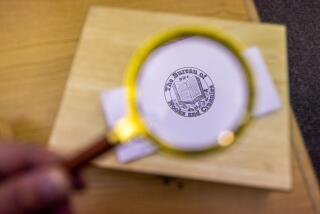“Those words, ‘Once upon a time,’ they’re magic. They open a world for you.” : Phone Tales Can Open World of Books to Children
- Share via
Each day, nearly 1,000 Orange County children pick up the telephone and catch up on the latest adventures of literary characters such as: Wilfred the Rat, Winkin, Blinkin and Nod, The Man Who Didn’t Wash Dishes, Casey at the Bat and Mr. Weird.
And in the bargain, say children’s reading specialists and educators, they are probably getting a jump on literacy and developing an early affection for good stories, good books and their local library.
The stories in English and Spanish have been pouring out of receivers throughout the county, mostly toll-free, 24 hours a day, seven days a week, at the average rate of 30,000 to 35,000 a month since the Orange County Public Library’s Dial-A-Story program began on July 1, 1974.
The program, the first of its kind in Southern California and one of the first in the nation, was designed as a type of teaser, a contact between younger children who have limited or no reading skills and the books available to them in the library, said Lynn Eisenhut, the library’s coordinator of children’s services.
Traditional Stories
“It makes stories accessible to children who can’t read yet or who don’t read well but who like to look at pictures or listen to a story being read,” Eisenhut said. “And we try to use stories that children can find in the library, so we lean toward the more traditional, like ‘The Three Billy Goats Gruff’ and ‘The Three Little Pigs.’ We know that some children come to the library after hearing a story and ask for the story they’d heard. They’re starting to develop a positive association with the library.”
And, according to a Cal State Fullerton professor, they’re also beginning to develop an affection for the written word through what many educators consider the best possible method: listening to stories being read aloud.
“Yes, I believe that it does turn children on to the library,” said Dr. Allen Zeltzer, an emeritus professor of theater, “because reading aloud is such a time-honored tradition. It prevails in every socio-economic situation. Let’s face it--everyone likes a story. Those words, ‘Once upon a time,’ well, they’re magic. As old as I get, I can still get excited when I hear them. They’re like ‘open sesame.’ They open a world for you.”
Since 1981, students from one of Zeltzer’s upper division classes, titled “Oral Interpretation of Children’s Literature,” have provided the voices behind an estimated 80% of Dial-A-Story’s inventory of tales. In a recording studio on campus, the students, many of whom are majoring in child development or education, face a microphone with an open book and spin children’s tales both new and traditional that will eventually be heard by thousands of young ears.
Not a Substitute
However, Zeltzer said he believed Dial-A-Story shouldn’t be used as a substitute for the real thing.
“I don’t think it can take the place of live reading at home,” he said. “Reading to your children at home is such a wonderful form of family bonding. But it’s possible that some parents are just telling their children to go call Dial-A-Story if they don’t want to read to them themselves. Although it might be possible that if the parents see the children so interested in Dial-A-Story and maybe asking to be taken to the library, it might encourage those parents to read aloud to them.”
With national campaigns to combat illiteracy gaining momentum in recent months, more and more educators and reading specialists are encouraging parents to read aloud to their children at early ages, even before the children have received any reading instruction in school. Dial-A-Story, said a Cal State Fullerton professor of reading education, may be a reminder and a catalyst for parents.
“If kids are bored at home, and maybe the parents don’t feel comfortable reading to them, they can tell the kids to call Dial-A-Story and maybe create a kind of spark,” Dr. Ashley Bishop said. “It’s nowhere close to being the perfect situation, but it’s a much better substitute for no literature at all. If the parents don’t feel comfortable reading, something like this is a good vehicle for the child to hear what literature sounds like. And the most powerful thing in literature is language.
“The best thing we know about (Dial-A-Story) is that it’s motivational. When the child hears the story, he’s told that he can go to the library and get that book. That’s powerful.”
At one point in Dial-A-Story’s operation in 1979, demand not only exceeded supply, it nearly blew it up. As a result of what Eisenhut said she believes was a strong response to a widespread advertising campaign for the program at the time, nearly 68,000 calls per month flooded the Dial-A-Story lines, straining the capacity of the recording machines nearly to the breaking point.
John Pearson, a media specialist for the library who set up the mechanics to handle the incoming calls, is now installing new machines in each of the library’s four county branches that offer the program (each branch has one line for English stories and one for Spanish) and said they should be able to handle the expected surge in calls when the library begins a new advertising campaign on Dial-A-Story in about two months.
The four library branches that offer Dial-A-Story are located strategically so that callers within the county will not have to pay a toll. However, Eisenhut said, there may be sections of the county where calls must cross over telephone service-area boundaries and the caller’s bill may show a small toll.
The stories, Eisenhut said, are changed each Monday. They are voiced mostly by Zeltzer’s students but, she added, about 15% are recorded by library staff members and another 5% by community volunteers.
Though the stories are designed to appeal to children from pre-school age through the third grade, Eisenhut said older children enrolled in English-as-a-second-language classes also have made use of Dial-A-Story to practice their fluency.
Also, she said, library workers are hoping Dial-A-Story is introducing the children of the late 1980s to classic plots and characters that were familiar to their parents but are less so today.
“Many children are going through school now not knowing some of these traditional stories, like some of the Mother Goose stories,” Eisenhut said. “They wouldn’t be able to tell you the plot. And sometimes when they get older, they’ll be reading another book that alludes to one of these stories, and they won’t be able to understand the meaning.”
The experience of hearing a story, rather than seeing it, is a spark to the imagination that Dial-A-Story tries to help kindle in children who may already have become dependent upon television for their storytelling, Eisenhut suggests.
“Watching too much TV seems to stifle the imagination,” she said. “The children are having the stories spoon-fed to them for 30 minutes at a time. Reading, or listening to stories being read, those are active activities. It’s difficult sometimes, because you have to admit that Goldilocks and the Three Bears seems pretty tame when He-Man is saving the universe.”
But, Zeltzer said, Goldilocks is a sure bet to outlast He-Man in the memory.
“It’s amazing how many times my students will say, before they start to read a story in my class, how that story was their favorite as a child, or how their father or mother read that story to them and they’ve never forgotten it,” he said. “When you read to youngsters, you instill in them the love of stories and adventures and they never, never forget them.”
Within two months, Pearson and Eisenhut said, the Orange County Public Library will begin sending informational mailers about Dial-A-Story to child care centers, preschools, elementary schools, high school home economics departments and other educational and child-care groups throughout Orange County in an attempt to encourage use of the program. While they acknowledge that the program is no substitute for parental story time at home, they say they’re hoping that children who call will remember that the stories came from the library.
“I had a mother tell me once that her 9-year-old daughter would call and listen to the stories, then go to the library to check out the book with the story she heard and then call up all her friends and read the story to them,” Eisenhut said. “That’s what we like to hear about.”
More to Read
Sign up for our Book Club newsletter
Get the latest news, events and more from the Los Angeles Times Book Club, and help us get L.A. reading and talking.
You may occasionally receive promotional content from the Los Angeles Times.








